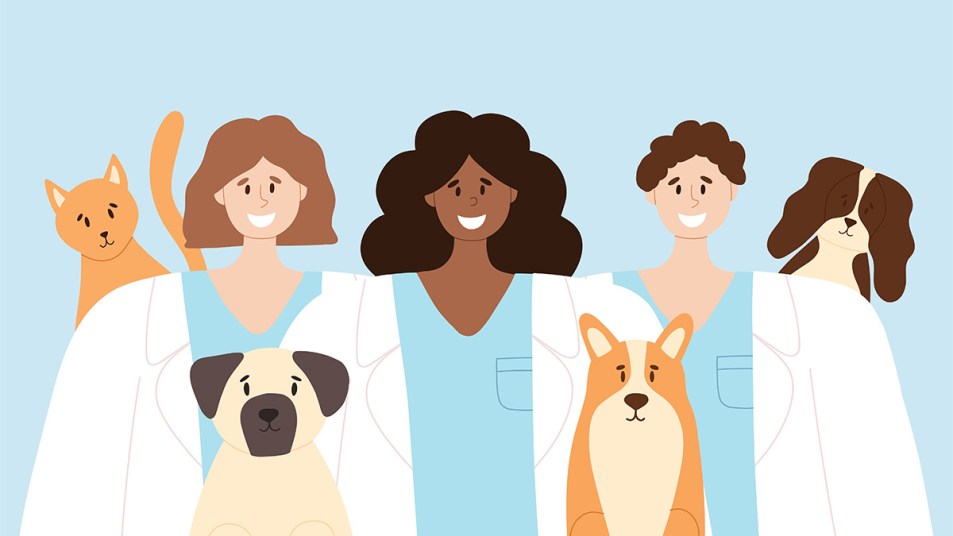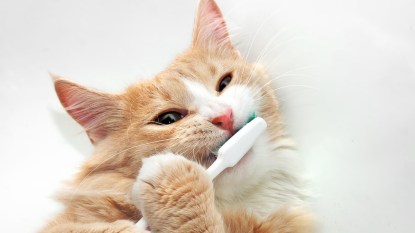For a No-Stress Vet Visit, Do These 7 Things, Say Veterinarians
Make your vet's job as easy as you can — they deserve it.

Life as a pet parent can be incredibly rewarding; nothing feels better than when Spot or Whiskers is happy, energized, and in good health. Nourishing your pet with a wholesome diet and allowing them to get adequate exercise are important steps to take — but routine visits to the vet are just as essential. Veterinarians dedicate their time and attention to providing pets with the best care, whether it’s a quick check-up or surgery for an illness.
But while caring for pets all day is undoubtedly fulfilling work, a vet’s job isn’t always easy. From working long hours to witnessing sad moments in which a pet and their owner have to say goodbye, this profession comes with an emotional toll. The good news? You can help! Pet owners don’t always adequately prepare their dog or cat for a vet visit — but if you want your trip to go as smoothly as possible for your pet and your vet, keep reading. There are seven easy ways you can make vet visits stress-free for everyone.
How To Prepare for a Visit to the Vet
Have you ever been nervous at the doctor? Pets can similarly become anxious or worried in the midst of a vet visit. Dogs may snap, growl, or pant as the vet is trying to perform an exam. Meanwhile, cats often prefer the safety of their home — so they’ll likely avoid eye contact or growl when they’re at the clinic. Fortunately, you can combat this behavior and avoid other hassles during vet visits by following these seven recommendations (that come directly from vets!).
1. Be prepared to bring medical documents.
“One thing that’s nice to have is a concise medical history. Oftentimes, we’ll get a new patient and the owner has not thought to bring their vaccination records or to have their medical history sent over to us. This can delay us providing treatment.” — Dr. Linda Simon MVB MRCVS, Veterinary Surgeon and Veterinary consultant for Dogaspet.com
2. Lead by example on the way to the clinic.
“When owners are anxious about a veterinary visit, those emotions are telegraphed to their pet. This increases their anxiety and their reactivity to being handled. One of the best things an owner can do to help their pet have a great veterinary visit is to be a calming presence for their pet.” – Wendy Hauser, DVM Peak Veterinary Consulting and Special Advisor to ASPCA(r) Pet Health Insurance
3. Make sure your pet is clean beforehand.
“If your dog has been out for a walk or playing in the mud, please wash and dry your pet before coming to the vet! It makes our job much easier and is a nicer experience overall for everyone. It also makes procedures such as blood sampling safer, as there’s less bacterial buildup on the skin.” – Dr. Corinne Wigfall, BVMBVS (Hons) BVMedSci (Hons), registered veterinarian and veterinary spokesperson for SpiritDog Training
4. Condition your cat to view the carrier as a safe and familiar place.
“The cat should be able to freely explore their carrier at home with the door off and treats inside. If a cat is comfortable in their carrier, they are less likely to arrive grumpy or covered in their own excrement [or bodily waste].” – Kristan Riley, DVM, at Heal House Call Veterinarian
5. Give your pet their medications if needed for anxiety and stress.
“If your pet receives anti-anxiety medications, please give these prior to a general wellness checkup. These medications help keep your pet calm, and will allow your veterinarian and their team to more easily work with your pet. It will also make the entire visit more stress-free and enjoyable for your pet.” — Danny Sack, DVM, a Big Barker Veterinarian Expert
6. Provide a video capturing your pet’s unusual behavior.
“If your pet is exhibiting an unusual symptom or behavior, grab a quick video before coming in — especially if it’s something episodic, like coughing or a seizure. This information is absolutely invaluable, and it saves me from having to do my impersonation of a reverse sneeze (it looks a lot like a pet is about to throw up but has a very different cause).” — Jessica Vogelsang, DVM, Chief Medical Officer at the American Animal Hospital Association (AAHA)
7. Bring Rover to the vet for an informal visit.
“For dogs, we recommend regular social visits where owners drop in with their dog to say hello, get a few treats, and leave without having to go through the actual exam or treatments associated with a regular vet visit. Dogs can learn that visiting our office is a fun and positive experience, so when exam time comes, it doesn’t seem so fearful.” — Dr. Kim DiMaio VMD, Owner and Founder of Main Street Vet
The Bottom Line
Your pet deserves the most thorough care at all times — and life will be a whole lot easier for both of you if they’re properly prepared for a vet visit. Whether this means bathing your pooch beforehand or remembering their medical records, doing your due diligence as a pet owner will make your vet’s job simpler and less stressful. For more pet care tips, check out our stories on how to tell if your dog or cat is choking and saying goodbye to your dog or cat before a vacation.













